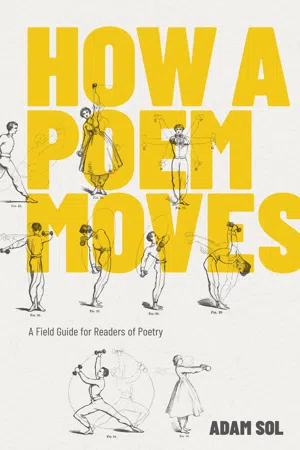
- English
- ePUB (mobile friendly)
- Available on iOS & Android
About this book
A collection of playfully elucidating essays to help reluctant poetry readers become well-versed in verse
Developed from Adam Sol's popular blog, How a Poem Moves is a collection of 35 short essays that walks readers through an array of contemporary poems. Sol is a dynamic teacher, and in these essays, he has captured the humor and engaging intelligence for which he is known in the classroom. With a breezy style, Sol delivers essays that are perfect for a quick read or to be grouped together as a curriculum.
Though How a Poem Moves is not a textbook, it demonstrates poetry's range and pleasures through encounters with individual poems that span traditions, techniques, and ambitions. This illuminating book is for readers who are afraid they "don't get" poetry but who believe that, with a welcoming guide, they might conquer their fear and cultivate a new appreciation.
Frequently asked questions
- Essential is ideal for learners and professionals who enjoy exploring a wide range of subjects. Access the Essential Library with 800,000+ trusted titles and best-sellers across business, personal growth, and the humanities. Includes unlimited reading time and Standard Read Aloud voice.
- Complete: Perfect for advanced learners and researchers needing full, unrestricted access. Unlock 1.4M+ books across hundreds of subjects, including academic and specialized titles. The Complete Plan also includes advanced features like Premium Read Aloud and Research Assistant.
Please note we cannot support devices running on iOS 13 and Android 7 or earlier. Learn more about using the app.
Information
How a Poem Moves
A Field Guide for Readers of Poetry

Contents
Table of contents
- Introduction
- How a Poem Puts Skin on a Mystery: Philip Levine, “Making Light of It”
- How a Poem Shapes Memory: Deborah Digges, “Stealing Lilacs in the Cemetery”
- How a Poem Articulates a Feeling: C.K. Williams, “Love: Beginnings”
- How a Poem Crystalizes an Image: Yusef Komunyakaa, “Yellowjackets”
- How a Poem Makes Meaning with Music: Elise Partridge, “Domestic Interior: Child Watching Mother”
- How a Poem Snapshots a Moment of Drama: Tiphanie Yanique, “My brother comes to me”
- How a Poem Seduces Us with Outlandishness: Diane Seuss, “Free beer”
- How a Poem Cooks Up Dark Insight: Philip Metres, “Recipe from the Abbasid”
- How a Poem Pushes Us Away and Beckons Us Closer: Marilyn Dumont, “How to Make Pemmican”
- How a Poem Wrestles with Its Inheritance: Rahat Kurd: “Ghazal: In the Persian”
- How a Poem Lives Between Languages: Natalia Toledo, translated by Clare Sullivan, “Flower That Drops Its Petals”
- How a Poem Invites Us to Praise: Ross Gay, “Ode to Drinking Water from My Hands”
- How a Poem Answers Some Questions but Not Others: Amber McMillan, “The Light I’ve Seen in Your Hair I Have Found in My Own Hands”
- How a Poem Clarifies Its Blur: Jeff Latosik, “Aubade Photoshop”
- How a Poem Changes As We Read: Ali Blythe, “Shattered”
- How a Poem Will (Not) Save Us: Raoul Fernandes, “Life with Tigers”
- How a Poem Loves a Misunderstanding: Richard Siken, “Dots Everywhere”
- How a Poem Mistrusts Its Idols: Cassidy McFadzean, “You Be the Skipper, I’ll Be the Sea”
- How a Poem Doesn’t Dish: Damian Rogers, “Ode to a Rolling Blackout”
- How a Poem Impersonates a Tomato: Oliver Bendorf, “Queer Facts about Vegetables”
- How a Poem Seeks New Models: Shannon Maguire, “[The most visible ants are]”
- How a Poem Makes Itself Out of Unusual Materials: Madhur Anand, “Especially in a Time”
- How a Poem Chooses the Apocalypse Behind Curtain #3: Jennifer L. Knox, “The New Let’s Make a Deal”
- How a Poem Assembles a Smashed Record for Posterity: George Murray, from “#DaydreamBereaver”
- How a Poem Tries to Connect Us, Despite the Obstacles: Donna Stonecipher’s “Model City [4]”
- How a Poem Welcomes Us to the Neighbourhood: Bren Simmers, “[Night of nesting dolls]”
- How a Poem Evokes Wonder: Sarah Holland-Batt, “Botany”
- How a Poem Reaches for Transcendence: Eric Pankey, “Ash”
- How a Poem Mourns: Don Paterson, “Mercies”
- How a Poem Confronts the Limitations of Our Empathy: Soraya Peerbaye, “Trials”
- How a Poem Tries to Get into It: Rowan Ricardo Phillips, “Little Song”
- How a Poem Chattily Wonders about Life’s Purpose: Ulrikka S. Gernes, “On H.C. Andersen Boulevard During Rush Hour”
- How a Poem Transforms a Stroll into a Ceremony: Joy Harjo, “Walk”
- How a Poem Imperfectly Reconciles Complexity: Liz Howard, “A Wake”
- How a Poem Haunts: Norman Dubie, “Lines for Little Mila”
- Conclusion: A Few Hopes
- Notes on Permissions
- Acknowledgements
- About the Author
- Copyright